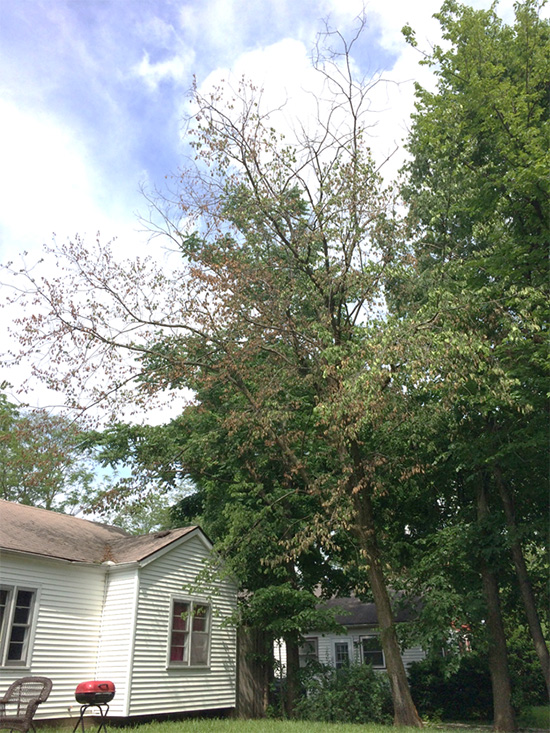Issue 7, June 6, 2016
Dutch Elm Disease
Dutch elm disease (DED) is a destructive wilt disease caused two closely related fungi, Ophiostoma ulmi and Ophiostoma novo-ulmi. Since its introduction to the United States in the 1930s (Illinois 1950s) DED has killed millions of native elm trees. American elm (Ulmus Americana) and red elm (Ulmus rubra) are very susceptible. Asiatic elms, Lacebark elm (Ulmus parvifolia) and Siberian elm (Ulmus pumila), are the most resistant species.
DED is still common in Illinois and the University of Illinois Plant Clinic confirms numerous cases on an annual basis. In Illinois, most new DED infections are first observed during June. Infections often begin in the upper crown, with symptoms first appearing at the end of an individual branch (called "flagging"). Leaves on affected branches wilt, turn a dull green to yellow, and then brown before dropping prematurely. The infection progresses through the tree rapidly. Once in the tree's vascular system, the fungus produces toxins that in turn induce the tree to form gums and tyloses that plug the water-conducting cells, greatly restricting the flow of water from roots to the foliage. Elms infected during early summer usually die in one year, small trees within a few weeks, and larger elms may die slowly, sometimes over two or more years.
The pathogen can be spread by root grafts or bark beetles (native and introduced). The beetles feed, lay eggs, hatch from eggs, and create a series of tunnels or galleries in the wood. The adult beetles eventually emerge from diseased trees and carry the sticky spores of the DED fungus to healthy elm trees.
Positive identification of DED requires culturing and identification of the causal fungus. Cultures are done with live wood taken from symptomatic branches showing vascular streaking. The ideal branch size is thumb thickness and 6 to 8 inches long.
Confirmed DED-infected elms should be immediately removed and destroyed to prevent disease spread. If a new, upper-crown DED infection is detected early enough, the DED fungus can be eradicated from the tree by pruning out the diseased limb or limbs. While this can be a fairly aggressive procedure, it can be quite successful. Such pruning is most likely to work when less than 5% of the crown is affected. Be sure to disinfect pruning tools before making cuts.
Large elms growing within 25 to 50 feet of each other are likely to have root grafts. Root grafts should be mechanically severed before the disease tree(s) is removed.
Injections of systemic fungicides containing propiconazole or thiabendazole have been shown to prevent new infections and stop the fungal colonization of uninfected parts of the tree. These fungicides are rather costly and provide no guarantees. Injections should be made by trained arborists and technicians.

Elm tree infected with Dutch Elm Disease. Thinned canopy with wilted, brown foliage (Champaign, IL. June 2016).
A good selection of DED-resistant or tolerant varieties and hybrids are available to choose from. Many selections also offer insect resistance and desirable vase-shaped form upon maturity. The Morton Arboretum has a list of Elm cultivars and their descriptions at the following web address:
http://www.mortonarb.org/trees-plants/tree-plant-descriptions/elm-cultivars
Additional information on DED can be found within RPD No. 647 http://ipm.illinois.edu/diseases/rpds/647.pdf (Travis Cleveland)
Author:
Travis Cleveland